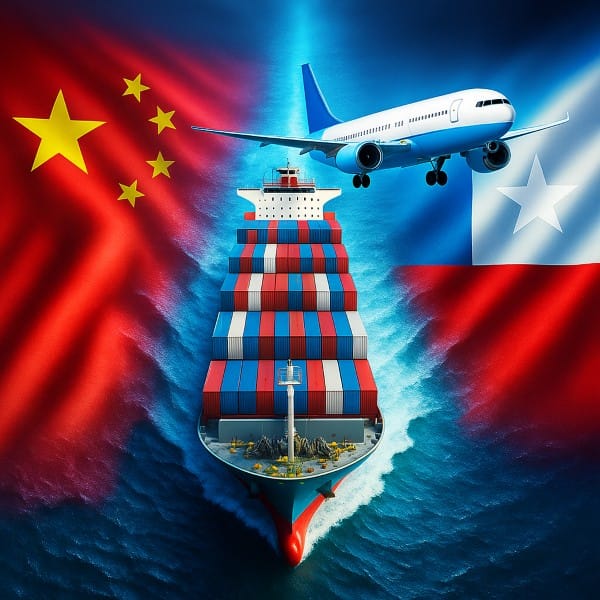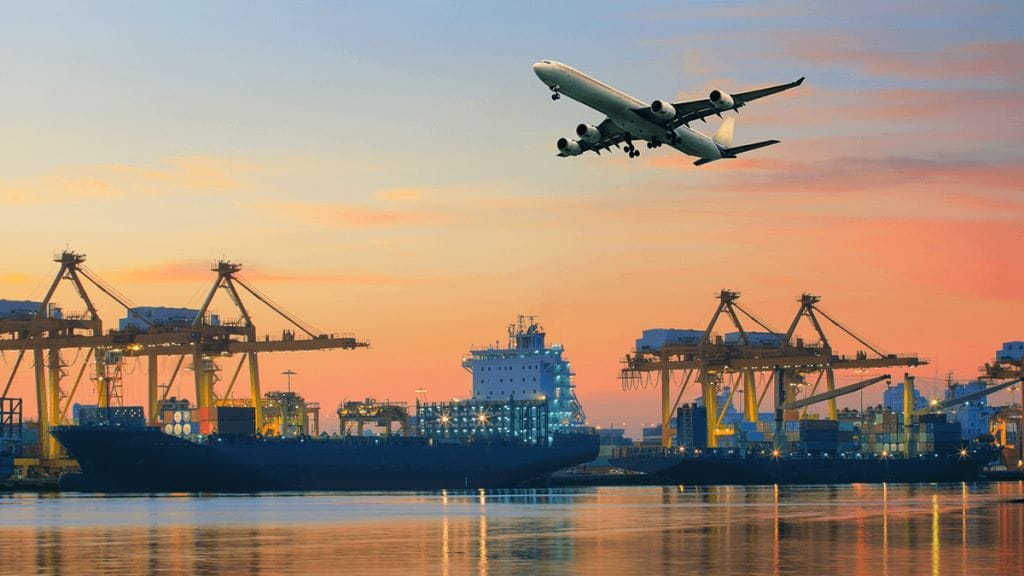The trade relationship between China and Chile has been stable for a long time. Chile is one of China’s important trading partners in Latin America. Chile has a mature import system and perfect port facilities, which enables Chinese goods to enter the Chilean market efficiently. This article will introduce the logistics between the two countries in detail.

How to Ship from China to Chile
Cargo transportation from China to Chile is the most promising international logistics route in the growth of trade in Central and South America in recent years. Common modes of transportation mainly include sea and air transportation. Sea transportation is suitable for large-scale, non-urgent cargo transportation, especially in the fields of export building materials, machinery and equipment, daily necessities, etc. It has a high cost-effectiveness; while air transportation is suitable for goods with high timeliness requirements or high value, such as electronic products, samples, etc.
Before arranging transportation, the shipper needs to prepare relevant documents and ensure that the packaging of the goods complies with international transportation specifications and import requirements of the destination country to avoid damage to the goods or customs clearance obstacles during transportation.
Due to the strict customs clearance procedures of Chilean ports (such as Valparaiso and San Antonio), it is recommended to understand the required information and specific requirements for customs clearance in advance before shipment. At the same time, the import tax rates and inspection standards of different goods in Chile may vary. It is recommended to cooperate with a logistics agent with experience in Chilean operations to ensure smooth customs clearance.
In addition, the delivery time should be planned reasonably to avoid Chilean holidays or port peak periods to avoid port congestion or inspection queues affecting the overall transportation cycle. Coordinating the entire transportation, customs clearance and delivery through professional freight forwarders will greatly improve the efficiency and safety of cross-border logistics.
Sea Freight from China to Chile
Sea Freight from China to Chile is one of the important trade channels connecting Asia-Pacific and South America, especially suitable for the export of bulk goods and cost-sensitive products. Sea transportation mainly adopts the form of full container load (FCL) or less than container load (LCL), which can be flexibly selected according to the volume and timeliness requirements.
Full container load (FCL) is very suitable for companies that need to fill a whole container with bulk goods. Reduce the risk of damage and delays. Transportation usually has a shorter transportation time and is the first choice for goods with high timeliness requirements.
Less than container load (LCL) service is a practical choice. Multiple shipments from different customers can be consolidated into one container, saving costs while ensuring the safe transportation of your goods.
As Chilean customs has special access requirements for some categories (such as food, chemicals, and electrical products), it is recommended to understand the import standards in advance or entrust a freight forwarding company with Chilean operation experience to ensure smooth customs clearance and avoid additional port demurrage fees.
Air Freight from China to Chile
Air freight is a fast channel for transporting goods from China to Chile. It is widely used in cross-border transportation of time-sensitive, high-value-added or small-volume goods. Due to the shortened processing time, it improves the safety of goods and reduces risks.
At the operational level, air freight has strict requirements on cargo packaging, size, and weight, and ensures that the cargo labels are clear and meet the standards of the International Air Transport Association (IATA).
Air freight usually has higher scheduling reliability and fewer delays caused by weather conditions or port congestion. It can improve supply chain efficiency and customer satisfaction through timely delivery.
Major Airports and Ports in Chile
Efficient shipping from China to Chile relies heavily on strategic selection of key ports and airports. A good understanding of these entry points can significantly improve your supply chain efficiency and reduce overall shipping costs.
Major Ports
- Port of San Antonio: Chile’s largest and busiest container terminal. Cargo from China arrives here regularly due to its well-developed infrastructure, low port fees, and fast customs clearance.
- Port of Valparaiso: An important alternative port that handles large volumes of cargo, especially industrial equipment and raw materials.
Major Airports
- Santiago International Airport (SCL): Chile’s main international gateway and busiest airport, vital for cargo moving in and out of the capital.
Shipping Cost from China to Chile
Sea freight is the main logistics method for China’s exports to Chile, usually using container transportation. You can choose full container load (FCL) or less than container load (LCL) according to the volume of goods. Generally, it is charged according to the container size (20ft and 40ft charges) and CBM. Air freight is suitable for goods with high timeliness requirements, high value or small volume. The billing weight = the larger of the actual weight and volume weight (length × width × height cm ÷ 6000). The following are common charges:
| Shipping Mode | Shipping Cost |
| LCL (Less than Container Load) | $150 to $250 per cubic meter |
| FCL (Full Container Load) 20-foot | $3,790 |
| FCL (Full Container Load) 40-foot | $5,740 |
| Express Shipping | $6 to $8 per kilogram |
| Air Freight | $7.60 per kilogram |

Cost of Shipping 20ft and 40ft Containers from China to Chile
The cost of shipping from China to Chile varies depending on the mode of transportation, but is also affected by various factors. The distance between different ports in China and ports in Chile varies, and the costs vary. Details are as follows:
| POL (Port of China) | POL (Port of Chile) | 20ft Container Cost | 40ft Container Cost |
|---|---|---|---|
| Shanghai | San Antonio | $3000 – $3500 | $4200 – $4800 |
| Shenzhen | San Antonio | $3300 – $3800 | $4200 – $5000 |
| Ningbo | San Antonio | $3000 – $3600 | $4100 – $4700 |
| Shanghai | Valparaiso | $3000 – $3600 | $4200 – $5000 |
| Shenzhen | Valparaiso | $3000 – $3500 | $4400 – $5200 |
| Ningbo | Valparaiso | $3300 – $4000 | $4200 – $4800 |
Here are the costs for shipping to other countries:
How Much Does it Cost to Ship from China to Argentina
How Much Does it Cost to Ship from China to Brazil?
Shipping Cost from China to Chile
The shipping time from China to Chile mainly depends on factors such as the mode of transportation (sea or air), departure and arrival cities, customs clearance efficiency, port or airport operation status, etc.
Sea transportation generally departs from coastal ports in China (such as Shanghai, Ningbo, Shenzhen), via the Pacific route, around the west coast of South America, and arrives at major ports in Chile, usually taking 35-45 days.
Air freight from China to Chile usually does not have direct flights and needs to be transferred via the United States and Europe, usually taking 5-10 days.
| Port of Origin (China) | Port of Destination (Chile) | Air Freight Time | Sea Freight Time |
|---|---|---|---|
| Shanghai | San Diego | 4–9 days | 37–44 days |
| Guangzhou | San Diego | 5–10 days | 35–43 days |
| Ningbo | San Diego | 4–9 days | 35–45 days |
| Shanghai | San Antonio | 6–8 days | 36–42 days |
| Guangzhou | San Antonio | 5–9 days | 36–45 days |
| Ningbo | San Antonio | 5–8 days | 35–45 days |
The following are the shipping times from China to surrounding countries:
How Long Does it Take to Ship from China to Brazil
How Long Does it Take to Ship from China to Argentina

Customs Clearance Process and Taxes from China to Chile
Chile’s customs clearance process is relatively standardized and transparent, but for companies exporting to Chile, it is crucial to understand its process and tax composition:
Customs declaration
Declared by the importer or its authorized customs broker in the Chilean National Customs (Servicio Nacional de Aduanas) system, customs clearance documents:
- Commercial invoice
- Packing list
- Bill of Lading/Airway Bill
- Certificate of Origin
- Commercial contract
- Product compliance certificate (such as food, medicine, electrical appliances, etc. require special approval)
Cargo inspection
If the system identifies high risk or is subject to random inspection, the customs will conduct a physical inspection
Payment of taxes and fees
All taxes and fees must be paid before customs clearance (see below for details)
Release of goods
After customs release, the importer can arrange to pick up the goods, put them into storage or distribute them
| Product Category | VAT | Customs Duties |
| Electronics | 19% | 10% |
| Clothing | 19% | 6% |
| Furniture | 19% | 8% |
| Toys | 19% | 5% |
| Automotive Parts | 19% | 7% |
Why Choose Ubestshipping
Choosing a suitable freight forwarder is the key to ensure that the goods arrive at the destination smoothly, safely and in compliance with regulations. A good freight forwarder can not only save costs, but also help you deal with various customs clearance, transportation, warehousing and emergency issues. Reasons for selection:
- Qualifications and experience: International freight forwarder qualifications and familiar with logistics from China to Chile
- Destination network: Own customs clearance agent or cooperative company in Chile
- Service capabilities: Can provide one-stop services such as customs declaration, warehousing, trailer, insurance, etc.
- Price transparency: The quotation lists each fee in detail, whether there are hidden charges
- Communication response: Can respond to inquiries quickly, can provide logistics tracks, customs declaration tracking
Through this article, you can choose the appropriate mode of transportation from China to Chile, plan the customs clearance and documentation process, and match the support of professional freight forwarding. In the face of different cargo attributes and customer needs, the key to success is to flexibly choose the transportation plan.
